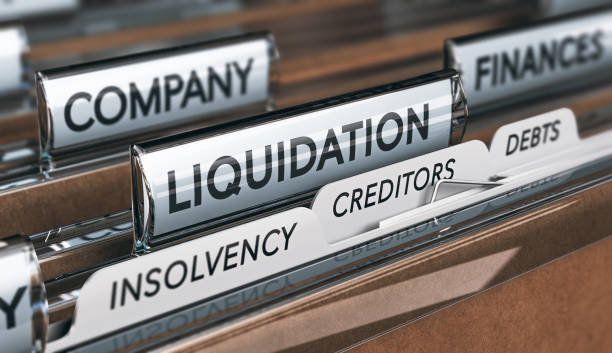Company Closure
Understanding Company Liquidation
The closure of a company can arise from various circumstances and ultimately leads to either a voluntary or compulsory process. Whether your company is being compelled into liquidation by a creditor or you have made the decision to wind up your company affairs Company Helpline’s expert team can advise on the best way forward. Whether your company is solvent or insolvent, liquidation is an intricate process and needs to be handled by a licensed insolvency practitioner.
There are 3 types of liquidation:
- Compulsory Liquidation
- Members’ Voluntary Liquidation (CVL)
- Creditors’ Voluntary Liquidation (MVL)

Understanding Company Liquidation
The closure of a company can arise from various circumstances and ultimately leads to either a voluntary or compulsory process. Whether your company is being compelled into liquidation by a creditor or you have made the decision to wind up your company affairs Money Helpline’s expert team can advise on the best way forward. Whether your company is solvent or insolvent, liquidation is an intricate process and needs to be handled by a licensed insolvency practitioner.
There are 3 types of liquidation:
- Compulsory Liquidation
- Members’ Voluntary Liquidation (CVL)
- Creditors’ Voluntary Liquidation (MVL)
Compulsory Liquidations

What is a compulsory liquidation?
A compulsory liquidation does not occur suddenly or in the early stages of a creditor’s debt collection process. It is typically a measure of last resort for creditors and is not taken lightly. When a company fails to effectively manage its liabilities and becomes insolvent, the closure of the company becomes inevitable.
Creditors often petition for the winding-up of a company if an agreement is not reached regarding the repayment of debts. This leads to the company being placed into compulsory liquidation.
What are the advantages and disadvantages?
Advantages
- Staff can claim redundancy pay
- Leases can be cancelled
- Legal action against the company can be stopped
- Can avoid petitioning through the courts
Disadvantages
- Any liquidation process brings with it an investigation into the directors’ conduct and dealings
- Personal liability for company debts
- Liability for overdrawn current accounts
What is the process?
Prior to deciding to liquidate the business, the director(s) would have been pursued for full payment or requested to agree to a feasible repayment plan.
The director(s) receive a statutory demand, allowing them 21 days to either pay the debt in full or contest it. If these conditions are not met, the creditor(s) may proceed with compulsory liquidation.
Compulsory liquidation is not only the creditor’s last resort but also the most severe and serious action that can be taken against your company.
The creditor’s commitment to closing your business is evident as they spend approximately £2,000.00 to issue a statutory demand and serve a winding-up petition.
Upon receiving a winding-up order, it is crucial to either contact the court within 7 days or seek assistance from a specialist for guidance. Failure to respond within 7 days will result in the court issuing a winding-up order, effectively instructing you to shut down your business.
Members Voluntary Liquidation

What is members voluntary liquidation?
A Members Voluntary Liquidation (MVL) is a process that enables shareholders to appoint a Liquidator to formally close a solvent company. Once the Liquidator has realised all company assets and ensured that there are no outstanding company liabilities, a capital distribution will be paid to shareholders either in species or from funds held in the company.
What are the advantages and disadvantages?
Advantages
- The liquidator winds up the company minimising risk to shareholders.
- Shareholders to have more control over the liquidati
- Requires the company to settle all its debts before distributing remaining assets to shareholders.
- Ensures that the final distribution is subject to Capital Gains Tax rather than Income Tax.
Disadvantages
- The control of the company’s assets passes to an Insolvency Practitioner
- Costs more than voluntary strike off / dissolution.
- The process can take several months to complete, depending on the complexity of the company's affairs.
- only suitable for solvent companies where shareholders agree to wind up the business voluntarily.
What is the process of a MVL?
The MVL process is handled by a licensed insolvency practitioner who will identify company assets, repaying any outstanding creditors, before distributing remaining funds to shareholders. The company will then be dissolved and will cease to exist as a legal entity.
Creditor Voluntary Liquidation

What is creditor voluntary liquidation?
When a limited company is insolvent – meaning either its debts are greater than its assets, or it is unable to pay its bills and other outgoings as and when they fall due – directors need to decide whether the company has a realistic possibility of being turned around, or whether it should be placed into liquidation.
What are the advantages and disadvantages?
Advantages
- Directors have more control as they voluntarily decide to initiate the liquidation process.
- Directors can claim redundancy claims on the liquidation of their company is some cases.
- Allegations of wrongful trading are reduced with a CVL.
- All unpaid debts are written off at the end of a Creditors’ Voluntary Liquidation, so creditors can no longer hassle you.
Disadvantages
- CVL results in the closure of the company, which is removed from the register at Companies House.
- Unfortunately, all staff are made redundant when a company enters Creditors’ Voluntary Liquidation.
- If directors have provided personal guarantees for any of the company’s borrowing, lenders will expect repayment.
- When a company enters Creditors’ Voluntary Liquidation, a public notice is placed in the Gazette.
When a company is liquidated the assets within are sold with the proceeds then distributed between creditors. This then results in the company being dissolves and ceasing to exist as a legal entity.
What is the process of CVL?
Liquidation is a formal process which beings about the end of a limited company. Once a company is knowingly insolvent, meaning it is no longer able to service its outgoings and debt liabilities as and when they fall due, the company may need to be placed into liquidation.
A licensed insolvency practitioner will be appointed to handle the process. It will be their role to identify all company assets before selling (or liquidating) these for the benefit of creditors. Any outstanding debts which remain after this process will be wiped out unless they have been secured by a director’s personal guarantee. The company will then be wound up with Companies House, its name removed from the register of limited companies; it will then cease to exist as a legal entity.
